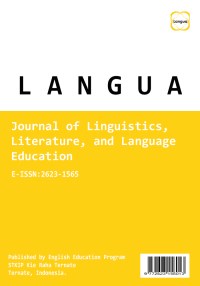An Analysis of students’ anxiety factors of EFL students’ Speech Production
Abstract
English Foreign Learners (EFL) students are considered to master English when the students can speak in English fluently which can be seen from their speech production. Nevertheless, becoming fluently competent is particularly difficult for foreign language learners as it is influenced by a number of factors. Among the several factors which affect foreign language learning especially speaking, anxiety emerges to be the crucial one that has a debilitating effect on the oral performances of students. This study was purposed to analyse speaking anxiety level and factors of English Foreign Language student’s anxiety in speech production. The data were gathered from qualitative research with random sampling conducted on the second semester consist of 30 students taking Speaking for Academic Communication class at Hamzanwadi University. A closed-ended questionnaire of Foreign Language Classroom Anxiety Scale and semi-structured interviews was administered to the participants to explore the anxiety level and the factors of their anxiety in speech production. The results show severe anxiety level which indicated that students are highly anxious when speaking English. Furthermore, the findings revealed that the factors contributed to the students’ speaking anxiety were shyness with audience, fear of not being able to convey the message well, lack of preparation, low self-confidence and low-proficiency.
Keywords: foreign language anxiety, speaking anxiety, speech production, anxiety factors
Downloads
References
Genard, G. (2015). 10 causes of speech anxiety that create fear of public speaking. The Genard Method.
Hales, D. (2010). An introduction to triangulation. Geneva: UNAIDS Monitoring and Education Division, 13-17.
Hamilton, M. (1959). The assessment of anxiety states by rating. Br J Med Psychol, 32, 50-55. https://citeseerx.ist.psu.edu/viewdoc/download?doi=10.1.1.964.6326&rep=rep1&type=pdf.
Horwitz, E. K., Horwitz, M. B., & Cope, J. (1968). Foreign language classroom anxiety. The Modern Language Journal, 70(2), 125-132. https://doi.org/10.2307/327317
Liu, J., et. al. (2007). Anxiety like behavior. Endocrinology, 148(11), 5531-5540. https://academic.oup.com/endo/article/148/11/5531/2501637
Lizuka, K. (2010). Learner coping strategies for foreign language anxiety. JALT2009 Conference Proceedings, 103-112. https://jalt-publications.org/archive/proceedings/2009/E065.pdf.
Marwan, A. (2007). Investigating Students’ English Language Anxiety. Malaysian Journal of ELT Research, 3, 39. https://www.melta.org.my/journals/MAJER/downloads/majer03_01_04.pdf.
Marwan, A. (2008). The Exploration of Factors Triggering Foreign Language Anxiety: Learners’ Voice. Teflin Journal, 19(2), 119-126. http://journal.teflin.org/index.php/journal/article/view/102.
Miles and Huberman. (2018). An Expanded Sourcebook Qualitative Data Analysis Second Edition. California: SAGE Publications, Inc.
Pull, C. B. (2012). Current status of knowledge on public-speaking anxiety. Current opinion in psychiatry, 25(1), 32-38. doi: 10.1097/YCO.0b013e32834e06dc
Sjaifullah, A. (2019). An analysis of EFL students’ anxiety factors in speaking. International research journal of engineering, IT & scientific research, 5(3), 43-48. https://core.ac.uk/download/pdf/230597793.pdf.
Stein, M. B., & Stein, D. J, (2008). Social anxiety disorder. The lancet, 371(9618), 1115-1125. https://doi.org/10.1016/S0140-6736(08)60488-2
Tanveer, M. (2007). Investigation of the factors that cause language anxiety for ESL/EFL learners in learning speaking skills and the influence it casts on communication in the target language. University of Glasgow, Scotland. https://www.researchgate.net/profile/Muhammad-Tanveer-3/publication/293263722_Investigation_of_the_factors_that_cause_language_anxiety_for_ESLEFL_learners_in_learning_speaking_skills_and_the_influence_it_casts_on_communication_in_the_target_language/links/56b6f15408ae3c1b79ad4ce7/Investigation-of-the-factors-that-cause-language-anxiety-for-ESL-EFL-learners-in-learning-speaking-skills-and-the-influence-it-casts-on-communication-in-the-target-language.pdf.
Tarigan, (2009). Metode Pengajaran Bahasa. Bandung: Angkasa Bandung.
Copyright (c) 2022 zahratul fikni

This work is licensed under a Creative Commons Attribution 4.0 International License.
Authors who publish with Langua Journal of Linguistics, Literature, and Language Education agree to the following terms:
- Authors retain copyright and grant the journal right of first publication with the work simultaneously licensed under a Creative Commons Attribution License that allows others to share the work with an acknowledgement of the work's authorship and initial publication in Langua.
- Authors are able to enter into separate, additional contractual arrangements for the non-exclusive distribution of the journal's published version of the work (e.g., post it to an institutional repository or publish it in a book), with an acknowledgement of its initial publication in Langua.
- Authors are permitted and encouraged to post their work online (e.g., in institutional repositories or on their website) prior to and during the submission process, as it can lead to productive exchanges, as well as earlier and greater citation of published work.






